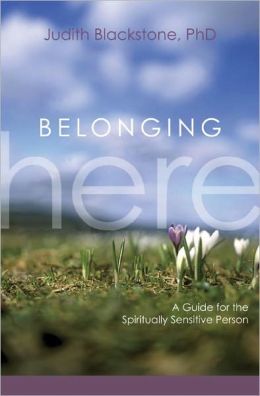
Some spiritually sensitive people are so empathetic they cannot function well in social settings. Others experience sensations that make them feel as if they are not in their own bodies. These are a few of the topics mentioned in Dr. Judith Blackstone, Ph.D. addresses in her book, Belonging Here: A Guide to the Spiritually Sensitive Person. Blackstone uses tools like self hypnosis, Hindu Yogas, Taoist, Zen and Central Channel Yoga exercises to assist the spiritually sensitive person become more grounded, and more comfortable in living in his or her own skin, and more resilient. She follows up with exercises to help the spiritually sensitive person become stronger, and better capable of living in the world.
The second section of the book contains anecdotes taken from her clientele, and uses these examples to reinforce the earlier exercises.
Dr. Blackstone has over 30 years of experience in psychotherapy. There times when she tends to forget that and writes above people’s heads. The book isn’t impossible to read, but, if a reader has no background in psychology or psychiatry, what she discusses could be a bit daunting.
None of the meditation techniques that Dr. Blackstone proposes are dangerous, per se. However, they can be misunderstood or misused. Someone who is spiritually sensitive, for example, may decide to try one of the central channel yogas that Dr. Blackstone describes in her book. The reader may find themselves lingering too long inside their central channel, or may focus too much on one particular chakra, which, I have learned from personal experience, and under the guidance of my Lama, still found myself feeling even more ungrounded or even irritable after the practice was over. I had to do a grounding practice afterwards to counteract the effect.
Another danger is to use these meditation techniques as a form of escapism. It is vital that the reader utilizes the practices to face their problems and become strong and resilient, not as a way to run and hide. My lama cautioned me ages ago, when I first started learning the higher Tantric Yogas that when obstacles arose, “not to crawl into my central channel and hide there.”
Yes, it’s true that being spiritually sensitive can be an obstacle on the path. But what most Buddhist and other meditation students don’t realize is that freeing ourselves from obstacles isn’t the path. The obstacles are the path. Use the techniques Blackstone suggests, yes, but utilize them in a way that makes you strong.
There are good things in Belonging Here, and there is considerable food for thought. However, to bring these techniques out in the most effective manner, I strongly suggest the reader find a qualified meditation teacher as well as discuss any mental or emotional health problems with a health care professional who can guide the reader further along on their journey.
Recommended.
~review by Patricia Snodgrass
Author: Judith Blackstone
Sounds True, Inc., 2012
pp. 203, $22.95
